#Tokyo Japan 1984
Explore tagged Tumblr posts
Text
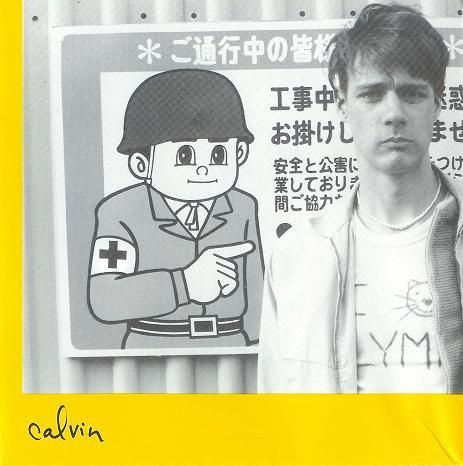
ON HOLIDAY IN THE FAR EAST -- SOAKING IN THE KAWAII VIBES ALL AROUND.
PIC INFO: Spotlight on Calvin Johnson, vocalist of American indie pop/lo-fi music group BEAT HAPPENING, during their mini-stay in Tokyo, c. 1984, during which they recorded their "Tea Tea Breakfast" cassette, a.k.a., the first official release by the group. 📸: Bret? Heather?
"When I was young I thought I was old, I sailed across the sea To Tokyo…"
-- "Youth" (1984) by BEAT HAPPENING
Source: www.pinterest.com/pin/111886371962581017.
#BEAT HAPPENING 1984#Tokyo Japan#Calvin Johnson#Indie/lo-fi#Photography#Indie pop#Indie#Tokyo#Lo-fi#1984#Welcome to 1984#Japan#Indie Style#Tokyo Japan 1984#Vintage Kawaii#80s#BEAT HAPPENING band#Kawaii#1980s#BEAT HAPPENING#Three Tea Breakfast#Indie Scene#K Records#Kawaiicore#BEAT HAPPENING Beat Happening 1985#Alternative/indie#Cover Art#Indie rock#BEAT HAPPENING Beat Happening#Lo-fi/indie
3 notes
·
View notes
Text
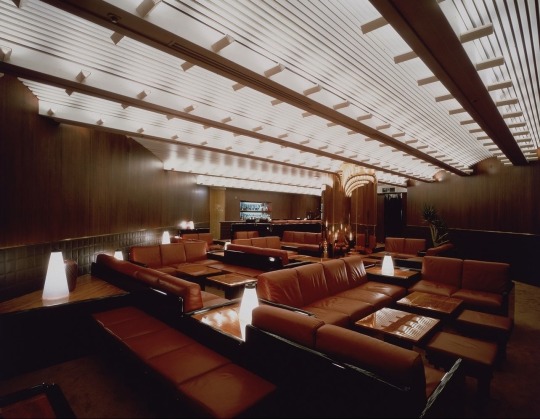
Gianfranco Frattini: Hilton Hotel Bar (1984) Located: Tokyo, Japan
#Gianfranco Frattini#Hilton Hotel#bar#interior design#japan#tokyo#lighting#sofa#lounge#brown#architecture#1984
1K notes
·
View notes
Text

Izakaya at JR Yūrakuchō Station underpass (1984)
居酒屋、有楽町駅 (1984年)
233 notes
·
View notes
Text

Today, on May 8th, 1985 - Queen Story!
Queen played the Nippon Budokan, Tokyo, Japan
'Works!' Tour
(August 1984/May 1985)
Pic: Queen backstage
📸 Photographer © Koh Hasebe
#1985#legend#brian may#queen#john deacon#freddiebulsara#zanzibar#london#queen band#roger taylor#freddie mercury#nippon budokan#japan#koh hasebe#shinko music#tokyo#the works#works tour 1984 1985#backstage
76 notes
·
View notes
Text
this video was made in november 2024 this video is about multiverse in different realities
youtube
#multiverse#parallel universe#cyberpunk 2077#cyberpunk#frutiger aero#horror#y2k aesthetic#y2k futurism#1984 george orwell#new york city#london#Seattle#beijing#life after people#alternate universes#solarpunk#san francisco#paris#united states#united kingdom#france#china#japan#tokyo#neo tokyo#earth atmosphere#night city#Youtube
4 notes
·
View notes
Text
𝔔𝔲𝔢𝔢𝔫𝔰𝔯ÿ𝔠𝔥𝔢 - 𝔗𝔥𝔢 𝔏𝔞𝔡𝔶 𝔚𝔬𝔯𝔢 𝔅𝔩𝔞𝔠𝔨
#Queensrÿche#In The Dead Of Night#The Lady Wore Black#Released:#1994#Track 6-14: Nihon Seinen-kan#Tokyo#Japan 5th of August 1984#Genre:#Progressive Heavy/Power Metal#Themes:#Fantasy#Technology#USA
14 notes
·
View notes
Text
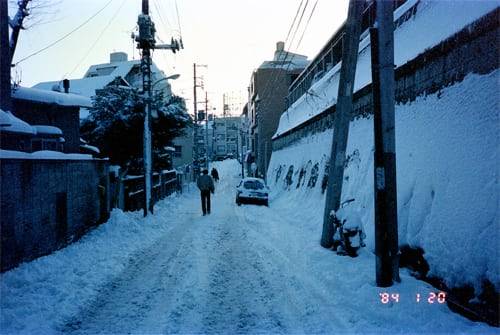
1984年、雪の東京・板橋
#Itabashi#Tokyo#Winter#Snow#Snow White#Snowscape#Cityscape#Japan#1984#84#80#80s#80s Photography#Photography#板橋#東京
3 notes
·
View notes
Text

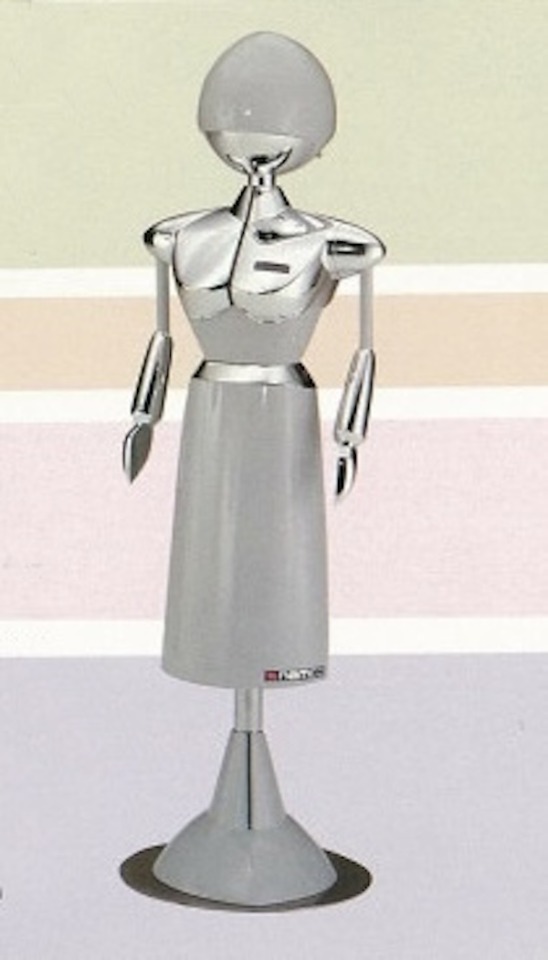







Explanation Komachi (Information Robot) by Hiroshi Sasaki and Hiroshi Fuji, Namco, Tokyo, Japan (1984). "This is a robot that provides product PR and in-store information at stores and on the sales floor. Both arms and chest move, and combined with the included color TV monitor, gestures and voice convey information to customers in an interesting way. Since images, gestures, and audio are pre-programmed, it's easy to create a simple show. Additionally, a software editing system is available as an option that allows users to easily program them. The design is in the image of an elegant woman, suitable for showrooms and high-end stores."
"Although the color and some functions are different, the appearance and approximate specifications are almost the same as the current reception Komachi. It has functions that give it a somewhat old-fashioned feel, such as VCR playback. About 10 units were produced, and recently it could be seen in Yubari City, Hokkaido [The silver Komachi was on show at the Yubari Robot Museum until it closed in 2008] … The Reception Komachi was created by making improvements on the explanation Komachi. The design was handled by Mr. Sasaki and designer Hiroshi Fuji (character designer for the Valkyrie series, etc., currently a manga artist), and they came up with a number of color variations. The concept is "a stylish robot in the near future." I didn't add any three-dimensional objects such as eyes, nose, or mouth because I wanted the viewer to imagine a petite woman." – Pepper's senior robot, completed with the recklessness of the president of Namco!
304 notes
·
View notes
Text

• Satoru Anabuki (Japanese IJAAF Ace)
Lieutenant Colonel Satoru Anabuki 穴吹 智, Anabuki Satoru, was depending on the source, the second or third highest-scoring flying ace of the Imperial Japanese Army Air Force in World War II, with 39 victories (51 claimed).
Born into a farming family in the Kagawa Prefecture, he graduated high school to take the entrance examination for the Juvenile Flying Soldier School and entered the Tokyo Army Aviation School in April 1938, In Oct 1940, he was enrolled in Tachi'arai flight school in Fukuoka Prefecture graduating in March 1941 in the 6th Juvenile Soldier Course and receiving a promotion to corporal in October. He was assigned to the 3rd Company of the 50th Air Squadron, stationed on Formosa in 1941. With the outbreak of the Pacific War, he fought in the conquest of the Philippines, where he claimed his first victory, a Curtiss P-40, on December 22nd, 1941 flying a Ki-27 aircraft. On February 9th, 1942, he shot down two more.
He returned to Japan with his squadron in Apr 1942, where the squadron was re-equipped with Ki-43 Hayabusa aircraft; Anabuki named his new fighter "Fubuki", partially based on his own surname. In Jun 1942, his squadron was transferred to Burma, where he would see combat over Burma, India, and southwestern China. He was promoted to the rank of sergeant in Dec 1942. On December 20th, 1942, he shot down a Blenheim bomber over Magwe, Burma, the first of many bomber victories. On December 24th, he shot down three British Hurricane fighters in combat over Magwe, Burma. In May 1943, he received a new Ki-43 fighter; he named this new aircraft "Kimikaze" after his wife Kimiko. He was seriously wounded in combat while flying "Kimikaze" over Rangoon, Burma on October 8th, 1943; after initial recuperation, he was transferred to the Akeno Army Flying School in Ibaraki Prefecture, Japan in Feb 1944.
In late 1944, after being cleared to fly once again, he shot down four US F6F Hellcat fighters over Takao, Taiwan and the Philippine Islands while ferrying Ki-84 Hayate fighters from Japan southwards. In December 1944, he was promoted to the rank of sergeant major. In the final months of the war, he was an instructor at Akeno with frequent combat assignments; in this role, he scored his 39th and final confirmed victory (53rd claimed victory), a B-29 bomber, over Japan while flying a Ki-100 fighter. After the war, he joined the Police Reserve in 1950, eventually reaching the rank of captain. Later, he joined the Japan Ground Self-Defense Force, becoming a helicopter pilot stationed in northeastern Japan; he retired from his military career in 1971 at the rank of lieutenant colonel. He worked for Japan Airlines before retiring in 1984. Many of Anabuki's victory claims during the Burma Campaign have been contested by comparing them to Allied records of lost aircraft on particular occasions. In several cases, there were no records of Allied planes even operating in the area where the claims were made. Anabuki passed away on an unknown date in June of 2005 at the age of 83 years old.
#second world war#world war 2#world war ii#wwii#military history#aviation#aviation history#ww2 aces#japanese history#imperial japan#airforce history
29 notes
·
View notes
Text

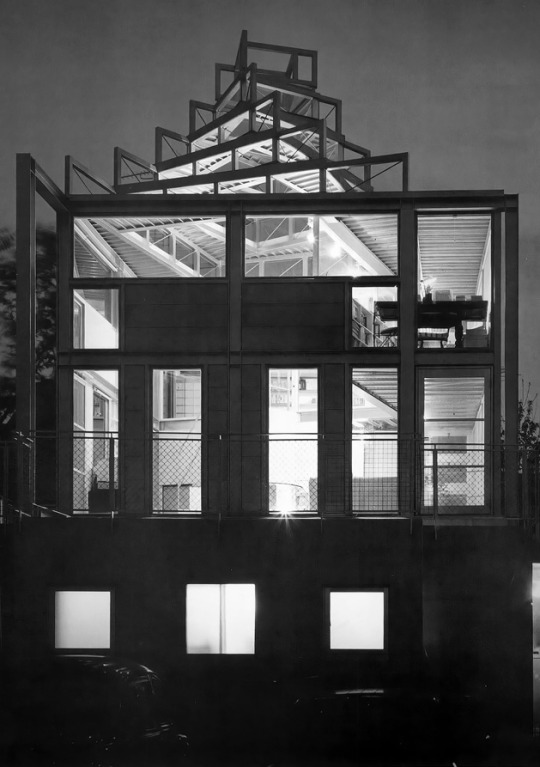
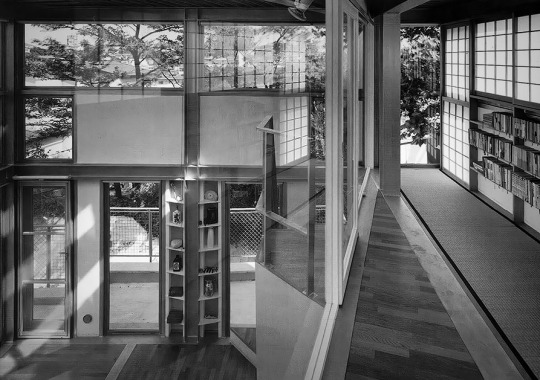
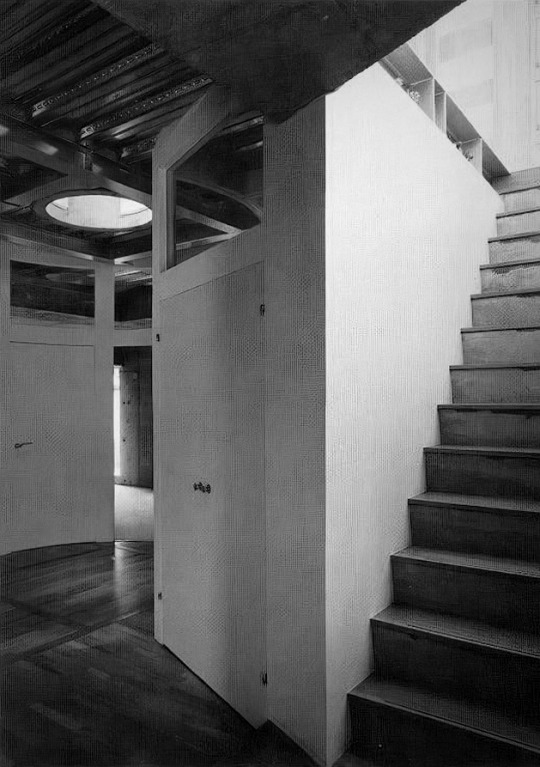

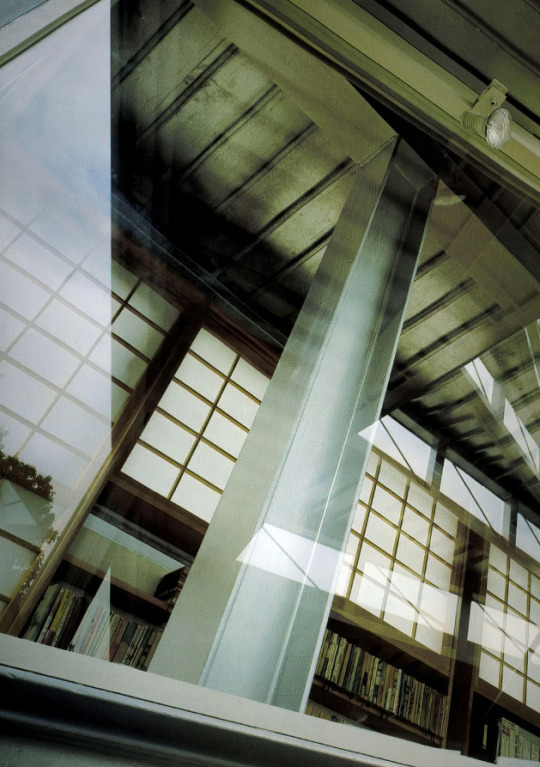



1129. Kazuhiro Ishii /// Spinning House (Ryoichi Enomoto House) /// Machida, Tokyo, Japan /// 1984-85
OfHouses presents: Japanese Fields OfHouses, part V. (Photos: © Mitsuo Matsuoka. Source: ‘Jutakutokushu’ 08/1985; Olga Popovic Larsen, "Reciprocal Frame Architecture", Oxford: Architectural Press, 2008.) — This project will be published in our upcoming book: ’Japanese Fields | OfHouses.’
#Fields5#Kazuhiro Ishii#Japan#80s#ofhouses#oldforgottenhouses#www.ofhouses.com#thecollectionofhouses#japanesefieldsofhouses
84 notes
·
View notes
Note
how many versions of cats were released on cd? I have the obc and olc versions so I was wondering if you knew what other versions there were, and if possible where to find them :D many thanks!
Hello Anon,
There are eighteen cast recordings:
Original London 1981 (both 2CD full recording and 1CD highlights)
Original Broadway 1982 (both 2CD full recording and 1CD highlights)
Vienna 1983 (1CD highlights)
Budapest 1984 (1CD highlights)*
Australia (Sydney) 1985 (2CD full recording)
Japan (Osaka) 1985 (2CD full recording)
Hamburg 1986 (2CD full recording)
Amsterdam 1987 (1CD highlights)
Paris 1989 (2CD full recording)
Japan (Nagoya) 1989 (2CD full recording)
Mexico 1991 (1CD highlights)
Warsaw 2004 (1CD highlights)*
Prague 2004 (1CD highlights)*
Dutch Tour 2006 (1CD highlights)
Italian Tour 2009 (1CD highlights)*
Japan (Tokyo) 2019 (2CD full recording)
2019 Movie (1CD highlights)
Vienna Revival 2021 (2CD full recording)
*Non-replica production, if that matters
In addition, there are a number of promo CDs that include a handful of tracks from the casts at the time of release:
Hamburg 1996 (3 track promo, assuming audio taken from 1986 cast recording)
Japan (Tokyo) 1996 (3 track promo)
CATS 1998 Elaine Paige (3 track promo; 'Memory' included, and two other non-CATS songs)
Japan (Osaka) 2001 (4 track promo)
Madrid 2003 (1 track 'Memory' promo)
Moscow 2005 (8 track promo?, two versions; both have 4 instrumental tracks)
Dutch Tour 2006 (3 track promo, audio from 2006 cast recording)
German Tent Tour 2011 (3 track promo)
Of everything listed above, the only ones I do not own are the Madrid 2003 'Memory' promo, Prague 2004 cast recording (a very rare CD that was scrapped before moving to production, only test/promo copies exist), and Moscow 2005 (another very rare promo release, only found with the press packages). Who knows if I can ever get my hands on them.
In terms of where to find them, the OLC, OBC, and Vienna 1983 are still being produced today and can be easily found new online, through Amazon or eBay (or better yet, in-person at your local music store!), and so is the Budapest 1984 CD as well (at least from what I can tell, it is always readily available brand new from Hungary). The 1989 and 2019 Japanese cast recordings are also still readily available brand new from Japan through the Shiki webstore. The 2019 movie highlights is also very easy to find, considering it just was released. The Vienna 2021 recording is still available from the label's website (at 45% right now!), but they only ship within Europe.
All the others can be found second-hand to varying degrees of ease online (i.e., eBay). The 1980s cast recordings are not too difficult, with Hamburg being fairly easily found, but as you start moving into lesser known (and shorter running) productions, it becomes more difficult to find them. Some are extremely uncommon, and I purchased the only copy I have even seen go for sale throughout the years, and I am still waiting for the chance to get the few I do not have.
Happy hunting to you, Anon!
33 notes
·
View notes
Text
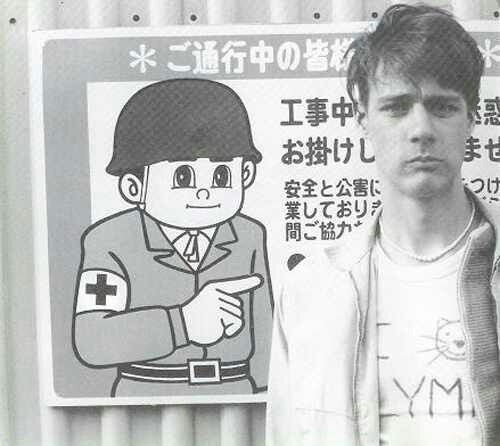
SIGHTSEEING IN TOKYO DURING THE "THREE TEA BREAKFAST" SESSIONS.
PIC INFO: Spotlight on Calvin Johnson, vocalist of American indie pop/lo-fi music group BEAT HAPPENING, during their mini-stay in Tokyo, c. 1984, where the band recorded their "Tea Tea Breakfast" cassette/demo, a.k.a., the first official release by the group. 📸: Bret? Heather?
Source: www.pinterest.fr/pin/464011567829627143.
#BEAT HAPPENING 1984#Calvin Johnson#Alternative/indie#Indie pop#Indie rock#Indie#Lo-fi/indie#Lo-fi#80s#1984#Indie Style#K Records#Indie Scene#Lo-fi pop#Indie/lo-fi#K Recs#Kawaii#Kawaiicore#Tokyo Japan#Photography#Three Tea Breakfast#Tokyo Japan 1984#BEAT HAPPENING band#Vintage Kawaii#BEAT HAPPENING#Welcome to 1984#BEAT HAPPENING Beat Happening#1980s#Tokyo#Japan
1 note
·
View note
Text
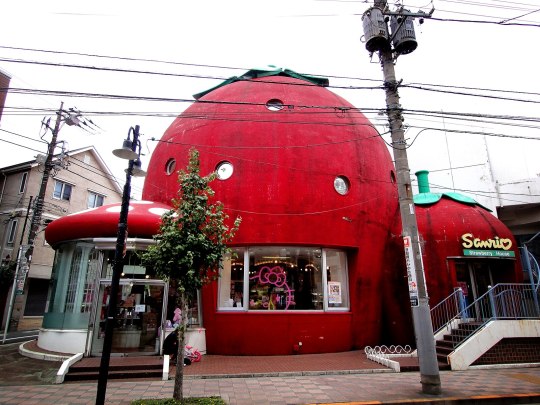
Sanrio: Strawberry House (October 2, 2011) 🍓🍄🏠
Built in 1984 - Demolished in 2012 💔
Tokyo, Japan 🇯🇵❤️
📸 Dick Thomas Johnson - Wikimedia Commons
#strawberry house#sanrio#sanrio shop#strawberry#strawberry aesthetic#kawaii#kawaii aesthetic#kawaii life#cute#retro#retro building#retro aesthetic#80s#80s nostalgia#80s aesthetic#doelette#doelet#otaku#otaku girl#geek#geek girl#cute aesthetic#tokyo#japan#demolished#kawaii girl
75 notes
·
View notes
Text

東京 (1984年)
295 notes
·
View notes
Text
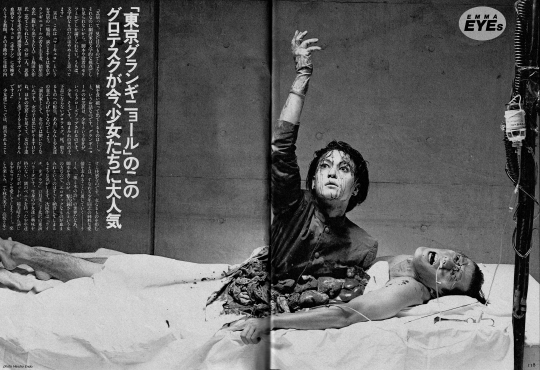
When it comes to books that act as ephemera for the Tokyo Grand Guignol’s plays, most collectors would seek out items like the retrospective 2-MINUS magazine Ameya Style or the volumes of Theater Book and June that featured contemporary articles about the TGG’s plays. The information included in these books is incredibly valuable as many production stills, descriptions and even whole screenplays were printed in these publications. That isn’t to downplay the importance of other adjacent books though, such as the Suehiro Maruo magazine Only You, which features a digest version of Galatia Teito Monogatari’s screenplay. There are even more magazines that have since been shrouded in obscurity, two of which acted as the direct source of several of the most iconic images affiliated with the Tokyo Grand Guignol. The above image is from the October 25th, 1985 volume of Emma magazine. My knowledge of these publications is pretty much nonexistent outside of the fact that on the auctions I found this (and the next featured book) on, both volumes were listed as “photo magazines” or something like that. They definitely contain pictures, that’s for certain. Either way, this photo was a specially shot production still derived loosely from a scene in the TGG’s first play, Mercuro (1984). Despite the close association, this photo is usually given with the play, there was no scene in the original screenplay where Ameya emerges from Kyusaku Shimada’s torso. It was said on the Twitter account TGG_Lab that this scene was based on a variation of the play that was performed at an event hosted by Peyote Workshop known as End of the Century Live, said version of Mercuro being a loose descendent of the iconic televised performance of the play that was shown on Tokumitsu Kazuo's TV Forum. Both renditions were heavily abridged variants of Mercuro’s most iconic special effects scenes, with the televised version specifically being a crossing of the openings of act one and act two. One thing of note is that near the end of the article on the side, a special teaser is given for the upcoming December 1985 debut of Litchi Hikari Club.
youtube
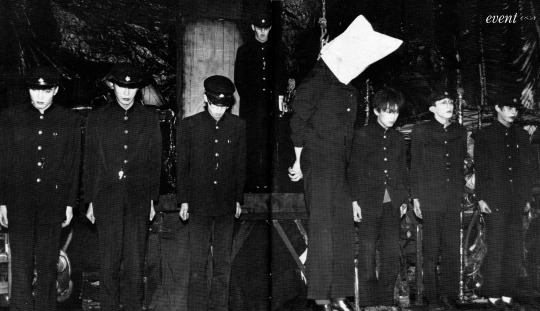
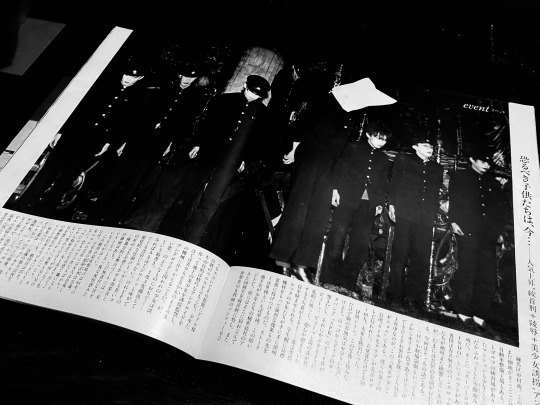

The next photo spread is of a similarly iconic production still, this one being a direct capture of (what was likely) the opening of the first act of Litchi Hikari Club. In said opening scene, an execution is conducted to the tune of the S.P.K. song Culturcide wherein the light club hang a student who crossed their strict rules. This student is apparently different from the one who is blinded by a spotlight later on in the same act. This photo is from the April 11th, 1986 volume of Focus, a magazine that happens to contain a fairly interesting coincidence. In my prior essay regarding the parallels between Litchi Hikari Club and the futurist movement, I mention how Ameya at one point cited an airplane accident as a direct influence for Litchi’s story. According to his recollections, the accident occurred not long after the televised performance of Mercuro, which was in 1985. While I originally had a hunch while writing the essay, I’m fairly certain the airline accident he’s referring to was the Japan Air Lines Flight 123 crash on the 12th of August, 1985. The time frame matches Ameya’s descriptions, and to this day it’s still recalled as being one of the deadliest airline accidents in history. In the same volume of Focus that this image came from, an article is featured a few pages earlier that concerns the accident. A description of Litchi's opening can be read in this excerpt from a lengthy Twitter thread by user Shoru Toji where she gives an in-depth description of the play's 1986 rerun and the subculture around it: I saw Litchi Hikari Club on March 27th, 1986, the first day of its rerun, at a live house called Super Loft KINDO. It was a renovated iron factory in the Tokyo Metropolitan area. The place was previously destroyed by Hanatarash with a live set where he went through the space with a bulldozer. If I recall correctly, the hall was illuminated by fluorescent lights from a high ceiling with exposed steel frames. The walls were painted black. The curtain separating the audience seating from the stage was a set of white sheets, like the kind you’d find in a hospital. There was no announcement when the play was ready to begin. Instead, the fluorescent lights suddenly went out, and a set of speakers in the ceiling emitted hissing noises. The stage was dimmed to the opening queue of Culturcide from the Seppuku Dekompositiones EP, and I thought to myself “This is SPK!”. And with the sounds of synchronized stomping and a ringing flute, the curtains were drawn back to show the scene of a line of students marching through the darkness in single file with lights hoisted over their shoulders. The way the lights aligned in their rows reminded me of spotlights. They marched all about the stage, going right, left, forward and to the back, all at once in an orderly manner. They were taking orders from a man standing on a podium. That man was Tsunekawa in the role of Zera. He stood with an overhead spot bathing him in red light. He pointed in many directions, with the students loyally following each command he made. Eventually, the left side of the stage began to loudly rattle with the starting of a U-shaped quarry conveyor belt. Another student is carted into the stage from the belt, screaming “Please, don’t do it! Please, forgive me!” as he’s suspended upside down from the belt. The light club place their lights in the back of the stage and hang their first victim at the front with a chain.
Sources: 1 - 2 - 3 - 4
147 notes
·
View notes
Text
I've been going through my collection of old (pre-2016 for the most part) academic papers on BL and thought, hey, why not re-read some of them and sum them up so folks can see whether they want to check them out in full?
Today's offering:
Beautiful, Borrowed, and Bent: “Boys’ Love” as Girls’ Love in Shōjo Manga by James Welker, originally presented at the Third International Convention of Asia Scholars, August 19–22, 2003, Singapore, and published in Signs, Vol. 31, No. 3, New Feminist Theories of Visual Culture (Spring 2006), pp. 841-870, UChicago Press. [Jstor]
Welker starts off with a brief explanation of what the BL genre is, what terminology he uses ("BL" as an umbrella term that includes the earlier names of tanbi, shōnen ai, yaoi, and the long-form 'boys' love'):
“Boys’ love” manga emerged as a subgenre of shōjo manga (girls’ comics) around 1970 just as women artists were taking over the shōjo market.(*) It quickly became among the most popular shōjo manga genres, and its creators became some of the best-loved artists in the industry. (* First published in the monthly Bessatsu shōjo komikku in December 1970, Keiko Takemiya’s “In the Sunroom” (Sanrūmu nite [1970] 1976) was probably the first boys’ love narrative. See Aoyama 1988, 188.) - Welker 2006:841
He goes on to challenge the common perception of BL as a genre "by straight women for straight women":
[T]he genre is widely considered to offer a liberatory sphere within which presumably heteronormative readers can experiment with romance and sexuality through identification with the beautiful boy characters. […] Members of the Japanese lesbian community have, however, pointed to boys’ love and other gender-bending manga as strong influences on them in their formative years […] Clearly boys’ love manga can be viewed through a different lens from that which most critics and scholars have been using, and hence the full potential of boys’ love is largely overlooked: that of liberating readers not just from patriarchy but from gender dualism and heteronormativity. - Welker 2006:842-843
He introduces the texts he will analyse (Takemiya Keiko's Song of Wind and Trees 風と木の詩 kaze to ki no uta, 1976-1984 and Hagio Motō's Heart of Thomas トーマの心臓 tōma no shinzō, 1974), and concludes the essay's intro section as follows:
This reading will employ lesbian critical theory, visual theory, and reader responses to these and similar texts to show how 1970s boys’ love manga is not merely queer on its surface but how it opened up space for some readers to experiment with marginalized gender and sexual practices and played a role in identity formation. - Welker 2006:843
Welker goes into the questions of applicability of theories that weren't originally developed for this specific context – visual theories were largely developed through film analysis; European and North American models of gender and feminist theory, while also having informed academic discourse in Japan, in their origin operate on culturally specific assumptions and need to be applied with care.
He talks about the tradition of androgynous and cross-dressing heroines of early shōjo manga and their connection to the earliest BL manga, the dilemma of the "beautiful boy" characters' gender and sex and how to read these – are they boys? idealised self-images of girls drawn onto boys' bodies? neither male nor female? sexless altogether?, and the way Japanese readers in the 1970s, already culturally familiar with gender performance through kabuki or the all-female Takarazuka Revue and similar troupes, received the gender-bending nature of BL stories. He also comments on the role fan interaction via magazines, and the way readers were learning about queer life in Japan:
By the early to mid-1980s, the magazines’ readers were learning in real terms about the world of Shinjuku ni-chōme, Tokyo’s well-known gay district, described as a world full of “beautiful boys like those in the world of shōjo manga” (Aran 1983, 15), as well as various aspects of lesbian life in Japan (Gekkō 1985). In spite of the connections drawn on the pages of these magazines, the possibility that these narratives might be seen to actually depict homosexuality remains broadly denied. To allow that the narratives might truly be about homosexuality—between these girls-cum-beautiful boys—would be an apparently unthinkable invitation to read the narratives as lesbian. - Welker 2006:857
Welker briefly explores how the example texts of Song of Wind and Trees and Heart of Thomas "serve many of the functions lesbian critics and theorists have outlined as roles of lesbian texts" (Welker 2006:858), then goes on to analyse the flower imagery of roses and lilies that is very prevalent in both titles, the intertextuality of these stories with European and French literature (and how the readers were expected to catch on to this intertextuality). On the transgressive and queering nature of writing and reading BL, he says:
[T]hrough acculturation to gender performance in Takarazuka and kabuki and by such cross-dressing manga icons as Sapphire and Oscar, as well as the deliberate ambiguity of the beautiful boy, the reader is encouraged to see not just a girl but herself within the world of boys’ love and, ultimately, is encouraged to explore homoerotic desire, either as a beautiful boy or as herself, either alone or with others, either as her fantasy or as her reality. […] Regardless of whether boys’ love manga were created merely to offer heterosexual readers a temporary respite from patriarchal restrictions on their desire, some readers found in identifying with the beautiful boy a way through the looking glass to a world outside the patriarchy. And regardless of whether he is read as a boy or a girl, the beautiful boy can be read as a lesbian. […] For readers whose experience of sexuality and gender contravenes heteronormativity, works like Song and Thomas offer narrative safe havens where they can experiment with identity, find affirmation, and develop the strength necessary to find others like themselves and a sense of belonging. - Welker 2006:865-866
I've been out of academia so long that I've lost any sense of what a good proportion of direct quotes to original text is, or whether it's even appropriate to quote as much as I did here. This is emphatically NOT an academic article in and of itself -- I'm posting on bloody tumblr. If anyone wants to add to this, I'll be thrilled.
One of the most commonly voiced criticisms of BL is that it's about, but not (or did not in significant part used to be) by or for gay men. This article does not address this point further—Welker does go into this in his more recent articles, iirc; if you've got beef with this aspect, @ him not me. I do however think it's worth noting that this 17-year-old article already recognises that the genre is queer, and has been since its inception.
#bl academia#bl theory#james welker#bl history#yeeting this into the void now#reading academic papers for fun not profit#my nonsense#watch me find errors or typos the minute I've hit post
111 notes
·
View notes